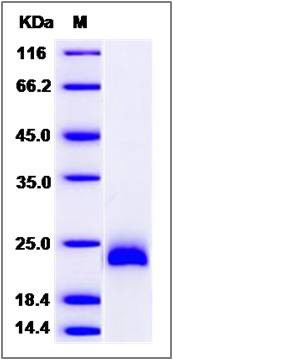Mouse ESM1 / Endocan Protein (His Tag)
0610042H23Rik,AV004503,ESM-1
- 100ug (NPP1266) Please inquiry
| Catalog Number | P51108-M08B |
|---|---|
| Organism Species | Mouse |
| Host | Baculovirus-Insect Cells |
| Synonyms | 0610042H23Rik,AV004503,ESM-1 |
| Molecular Weight | The recombinant mouse ESM1 consists of 173 amino acids and has a calculated molecular mass of 19.1 kDa. The recombinant protein migrates as an approximately 23 kDa band in SDS-PAGE under reducing conditions. |
| predicted N | Ala 22 |
| SDS-PAGE |  |
| Purity | > 95 % as determined by SDS-PAGE |
| Protein Construction | A DNA sequence encoding the mouse TLR2 (Q9QYY7) (Met1-Arg184) was fused with a polyhistidine tag at the C-terminus. |
| Bio-activity | |
| Research Area | Signaling |Signal Transduction |Other Related Intracellular Topics |Cellular Senescence and Pathways in Aging |Growth Hormone/IGF-I Axis |IGF Family | |
| Formulation | Lyophilized from sterile 20mM Tris, 500mM NaCl, pH 8.0, 10%gly 1. Normally 5 % - 8 % trehalose, mannitol and 0.01% Tween80 are added as protectants before lyophilization. Specific concentrations are included in the hardcopy of COA. |
| Background | ESM1 is a secreted protein which is produced by adipocytes. It has been noticed that ESM1 may play some role in obesity-associated vascular disease since circulating ESM-1 levels are reduced in the overweight and obese. ESM1 is mainly expressed in the endothelial cells in human lung and kidney tissues. The expression of ESM1 gene is regulated by cytokines, suggesting that it may play a role in endothelium-dependent pathological disorders. Recently, ESM1 has been described as a specific biomarker of tip cells during neoangiogenesis. Its expression has been shown to be increase in presence of pro-angiogenic growth factors such as VEGF or FGF-2. In hypervascularized cancers, overexpression of endocan has been detected by immunohistochemistry using monoclonal antibodies against ESM1. |
| Reference |
